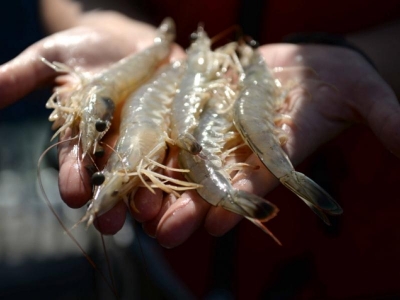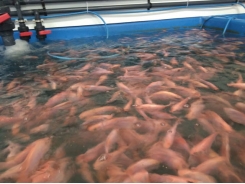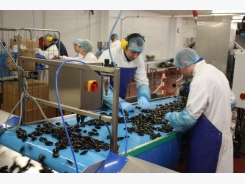Scientists continue study of black gill in shrimp

Scientists and naturalists with the Skidaway Institute of Oceanography and the Georgia Department of Natural Resources sort through sea life Oct. 12 aboard the RV Savannah during a trip to document black gill disease in shrimp off the Chatham County coast
A shrimp with black gill disease is seen on the left end of this sample taken via trawl off the Chatham County coast Oct. 11 during a trip on the RV Savannah by scientists from the Skidaway Institute of Oceanography to document the disease. (Dash Coleman/Savannah Morning News)
Marc Frischer, a biology professor at Skidaway Institute of Oceanography and lead scientist aboard the RV Savannah for an Oct. 11, research cruise off the Chatham County coast, provides details about recent research into black gill disease in shrimp
As the Research Vessel Savannah moved slowly along Georgia’s coast in early October, Wynn Gale calmly arranged about a dozen shrimp on a table inside one of the boat’s laboratories. He inspected each specimen for dark gill coloration, then he took a photo of the shrimp on his smartphone.
The photo, and Gale’s observations, will go into data that will be logged and examined by scientists at the University of Georgia’s Skidaway Institute of Oceanography, where researchers have been documenting an affliction in shrimp known as black gill. While the research has been ongoing for several years, the app is new, and is aimed at getting shrimpers to report what they see while on the job.
“I take the observations and leave little footnotes,” Gale, a fifth-generation fisherman from Darien, said of the app. “It’s pretty cool.”
Black gill, named because of a telltale dark coloration on the gills, is caused by a microscopic parasite. Scientists have determined that the parasite is a ciliate, a single-cell organism, but have yet to identify the specific type. Scientists say shrimp suffering from black gill are safe for humans to eat.
“It showed up about 20 years ago, and when it first started showing up, it really, really turned the industry on its head,” Gale said. “… Now, as time has progressed, (shrimp) are changing their game. I’ve been watching it and you can tell — they’re changing their game to circumvent it or prevent it.”
Gale was one of several “black gill stakeholders” on an Oct. 11 research cruise aboard the RV Savannah during which scientists went over their findings from the last year.

Tina Walters, right, a research professional at the Skidaway Institute of Oceanography, and Kirsten Rewis take samples from shrimp suffering from black gill disease in the wet lab of the RV Savannah on Oct. 11 (Dash Coleman/Savannah Morning News)
Black gill could be one of many factors contributing to a decline in commercial shrimp fishing, but there are other factors as well, said Marc Frischer, lead scientist on the research cruise and a professor at the Skidaway Institute.
Other contributors to decline in the industry include a decrease in the number of trawling licenses, competition from foreign seafood imports, increased operating costs and expensive upkeep of aging vessels, according to the institute.
Black gill has been spotted along the Georgia coast for about two decades now, and Frischer said it’s in the “epicenter” of where shrimp have tested positive for the cilia. But that’s subject to change.
“We’ve gotten samples all the way through the Gulf of Mexico to the Chesapeake Bay that also tested positive for this cilia,” he said. “… I suspect as we start looking further, if we get samples, which we’ll continue to try to do, we’ll find it probably globally.”
Typically, black gill starts showing up in July or August and disappears when the water cools down. Last year, which Frischer said was “unusual,” shrimp with black gill started showing up in May.
Frischer says the parasites are likely feeding on the gills. Experiments have shown that shrimp with black gill tend to have less endurance than shrimp without it, which has scientists wondering whether afflicted shrimp are more likely to get caught by predators in the wild.

Wynn Gale, a shrimp boat captain out of Darien, inspects shrimp suffering from black gill disease Oct. 11 during a research cruise aboard the RV Savannah. Gale wanted to document the shrimp in an app designed by the institute to help local shrimpers and scientists coordinate as they keep track of the disease. (Dash Coleman/Savannah Morning News)
“It could explain why we don’t have a body count,” he said.
Gale says he hopes scientists continue to focus on shallow water, especially near marsh grass. If the black gill-causing cilia don’t like cold weather, Gale says, shallow water that gets more sunlight would be a good place to hide. Plus, shrimp go into the marsh grass areas to feed at night, he said.
Gale said he’s pleased to see improved coordination between scientists and shrimpers over the last few years. He just hopes they get some more answers soon because, as he put it, “something freaky is going on.”
Related news
Tools

Phối trộn thức ăn chăn nuôi

Pha dung dịch thủy canh

Định mức cho tôm ăn

Phối trộn phân bón NPK

Xác định tỷ lệ tôm sống

Chuyển đổi đơn vị phân bón

Xác định công suất sục khí

Chuyển đổi đơn vị tôm

Tính diện tích nhà kính

Tính thể tích ao




 Top tips from expert for cleaner fish feeding
Top tips from expert for cleaner fish feeding  Shrimp sector electrification to improve competitiveness
Shrimp sector electrification to improve competitiveness